Page 493 of 504
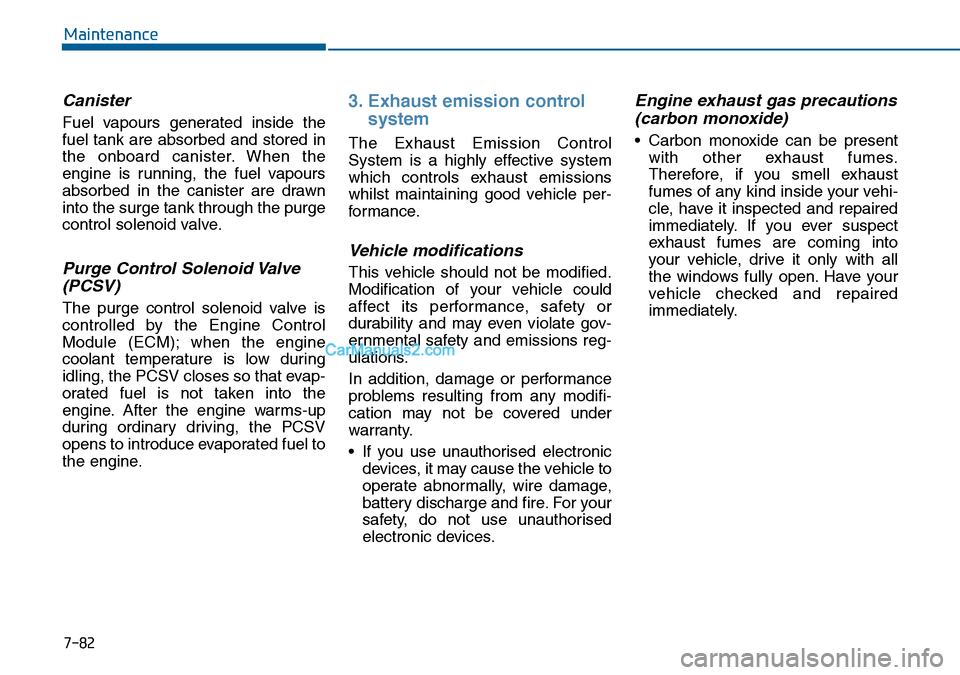
7-82
Maintenance
Canister
Fuel vapours generated inside the
fuel tank are absorbed and stored in
the onboard canister. When the
engine is running, the fuel vapours
absorbed in the canister are drawn
into the surge tank through the purge
control solenoid valve.
Purge Control Solenoid Valve
(PCSV)
The purge control solenoid valve is
controlled by the Engine Control
Module (ECM); when the engine
coolant temperature is low during
idling, the PCSV closes so that evap-
orated fuel is not taken into the
engine. After the engine warms-up
during ordinary driving, the PCSV
opens to introduce evaporated fuel to
the engine.
3. Exhaust emission control
system
The Exhaust Emission Control
System is a highly effective system
which controls exhaust emissions
whilst maintaining good vehicle per-
formance.
Vehicle modifications
This vehicle should not be modified.
Modification of your vehicle could
affect its performance, safety or
durability and may even violate gov-
ernmental safety and emissions reg-
ulations.
In addition, damage or performance
problems resulting from any modifi-
cation may not be covered under
warranty.
• If you use unauthorised electronic
devices, it may cause the vehicle to
operate abnormally, wire damage,
battery discharge and fire. For your
safety, do not use unauthorised
electronic devices.
Engine exhaust gas precautions
(carbon monoxide)
• Carbon monoxide can be present
with other exhaust fumes.
Therefore, if you smell exhaust
fumes of any kind inside your vehi-
cle, have it inspected and repaired
immediately. If you ever suspect
exhaust fumes are coming into
your vehicle, drive it only with all
the windows fully open. Have your
vehicle checked and repaired
immediately.
Page 494 of 504
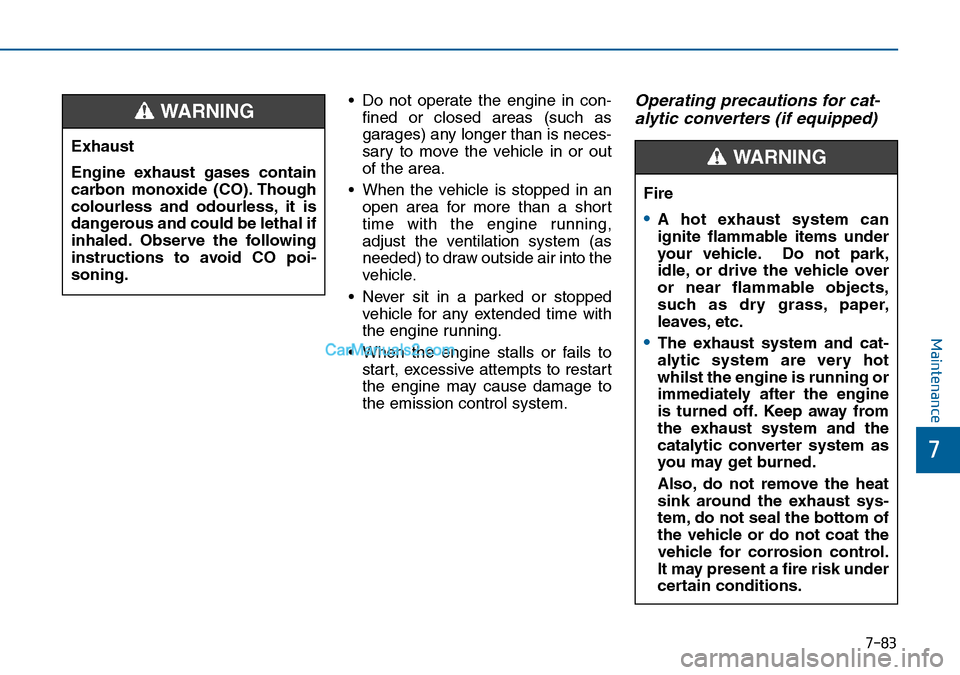
7-83
7
Maintenance
• Do not operate the engine in con-
fined or closed areas (such as
garages) any longer than is neces-
sary to move the vehicle in or out
of the area.
• When the vehicle is stopped in an
open area for more than a short
time with the engine running,
adjust the ventilation system (as
needed) to draw outside air into the
vehicle.
• Never sit in a parked or stopped
vehicle for any extended time with
the engine running.
• When the engine stalls or fails to
start, excessive attempts to restart
the engine may cause damage to
the emission control system.Operating precautions for cat-
alytic converters (if equipped)
Exhaust
Engine exhaust gases contain
carbon monoxide (CO). Though
colourless and odourless, it is
dangerous and could be lethal if
inhaled. Observe the following
instructions to avoid CO poi-
soning.
WARNING
Fire
•A hot exhaust system can
ignite flammable items under
your vehicle. Do not park,
idle, or drive the vehicle over
or near flammable objects,
such as dry grass, paper,
leaves, etc.
•The exhaust system and cat-
alytic system are very hot
whilst the engine is running or
immediately after the engine
is turned off. Keep away from
the exhaust system and the
catalytic converter system as
you may get burned.
Also, do not remove the heat
sink around the exhaust sys-
tem, do not seal the bottom of
the vehicle or do not coat the
vehicle for corrosion control.
It may present a fire risk under
certain conditions.
WARNING
Page 495 of 504
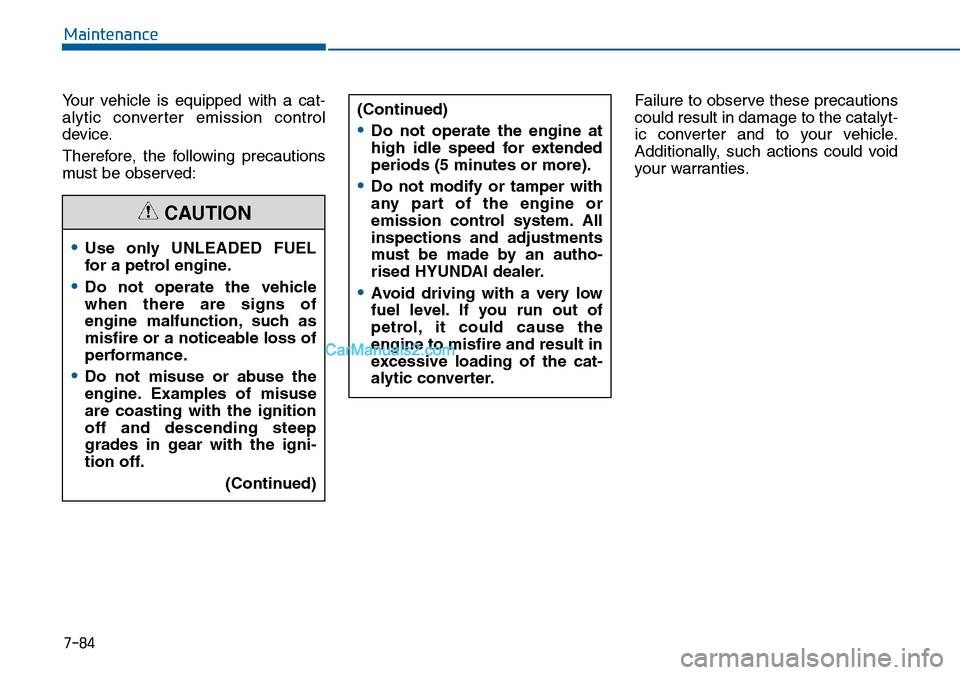
7-84
Maintenance
Your vehicle is equipped with a cat-
alytic converter emission control
device.
Therefore, the following precautions
must be observed:Failure to observe these precautions
could result in damage to the catalyt-
ic converter and to your vehicle.
Additionally, such actions could void
your warranties.
•Use only UNLEADED FUEL
for a petrol engine.
•Do not operate the vehicle
when there are signs of
engine malfunction, such as
misfire or a noticeable loss of
performance.
•Do not misuse or abuse the
engine. Examples of misuse
are coasting with the ignition
off and descending steep
grades in gear with the igni-
tion off.
(Continued)
(Continued)
•Do not operate the engine at
high idle speed for extended
periods (5 minutes or more).
•Do not modify or tamper with
any part of the engine or
emission control system. All
inspections and adjustments
must be made by an autho-
rised HYUNDAI dealer.
•Avoid driving with a very low
fuel level. If you run out of
petrol, it could cause the
engine to misfire and result in
excessive loading of the cat-
alytic converter.
CAUTION
Page 496 of 504
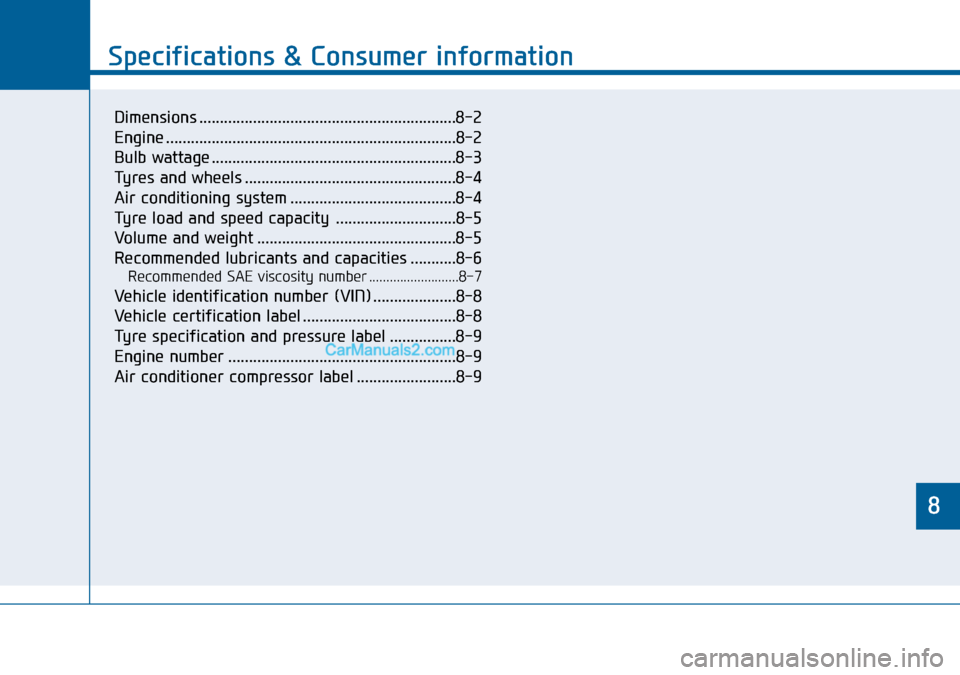
8
Specifications & Consumer information
8
Specifications & Consumer information
8
Dimensions ..............................................................8-2
Engine ......................................................................8-2
Bulb wattage ...........................................................8-3
Tyres and wheels ...................................................8-4
Air conditioning system ........................................8-4
Tyre load and speed capacity .............................8-5
Volume and weight ................................................8-5
Recommended lubricants and capacities ...........8-6
Recommended SAE viscosity number ..........................8-7
Vehicle identification number (VIN) ....................8-8
Vehicle certification label .....................................8-8
Tyre specification and pressure label ................8-9
Engine number .......................................................8-9
Air conditioner compressor label ........................8-9
Page 497 of 504
8-2
Specifications & Consumer information
DIMENSIONS
ENGINE
ItemTheta 2.0 Theta 2.4
Displacement
cc (cu. in)
1,998 (121.9) 2,359 (143.95)
Bore x Stroke
mm (in.)
86x86 (3.39x3.39) 88x97 (3.46x3.82)
Firing order
1-3-4-2 1-3-4-2
No. of cylinders
4, in-line 4, in-line
Itemsmm (in)
Overall length4,885 (192.3)
Overall width1,865 (73.4)
Overall height1,475 (58.1)
Front tread
205/65R161,614 (63.5)
215/55R171,602 (63.0)
235/45R181,597 (62.8)
Rear tread
205/65R161,621 (63.8)
215/55R171,609 (63.3)
235/45R181,604 (63.1)
Wheelbase2,805 (110.4)
Page 501 of 504

8-6
Specifications & Consumer information
*1: Refer to the recommended SAE viscosity numbers on the next page.
*2: Engine oils labelled Energy Conserving Oil are now available. Along with other additional benefits, they contribute to fuel economy by reducing
the amount of fuel necessary to overcome engine friction. Often, these improvements are difficult to measure in everyday driving, but in a year’s
time, they can offer significant cost and energy savings.
*
3: If the ACEA A5 engine oil is not available in your country, you are able to use ILSAC GF-4 (or above) or API SM (or above).
RECOMMENDED LUBRICANTS AND CAPACITIES
To help achieve proper engine and powertrain performance and durability, use only lubricants of the proper quality.
The correct lubricants also help promote engine efficiency that results in improved fuel economy.
These lubricants and fluids are recommended for use in your vehicle.
LubricantVolume Classification
Engine oil *
1*2(drain and refill)
RecommendsTheta 2.0 T-GDI4.8l
ACEA A5 *3or above
Theta 2.4GDI4.8lACEA A5 *3or above
Automatic transaxle fluidTheta 2.0 T-GDI
7.1l
MICHANG ATF SP-IV, SK ATF SP-IV
NOCA ATF SP-IV, HYUNDAI genuine ATF & SP-IV
Theta 2.4GDI7.8l
CoolantTheta 2.0 T-GDI
9.7 l
Mixture of antifreeze and water
(Ethylene glycol base coolant for aluminium radiator)
Theta 2.4GDI7.1 l
Brake fluid0.7~0.8 lFMVSS116 DOT-3 or DOT-4
Fuel70 lRefer to “Fuel Requirements” in the Foreword chapter.
Page 502 of 504
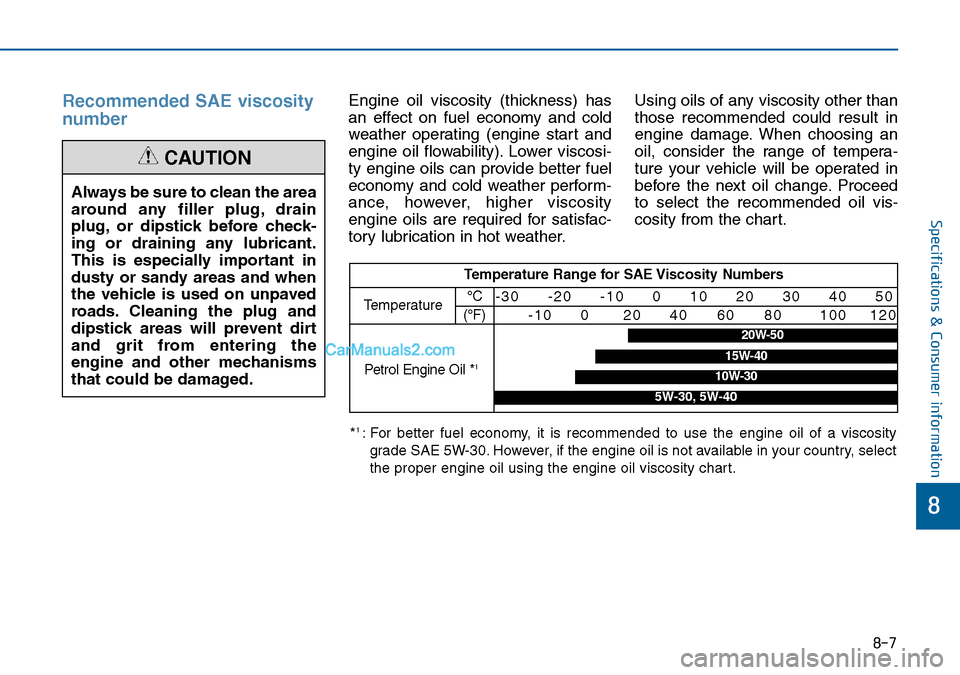
8-7
8
Specifications & Consumer information
Recommended SAE viscosity
numberEngine oil viscosity (thickness) has
an effect on fuel economy and cold
weather operating (engine start and
engine oil flowability). Lower viscosi-
ty engine oils can provide better fuel
economy and cold weather perform-
ance, however, higher viscosity
engine oils are required for satisfac-
tory lubrication in hot weather.Using oils of any viscosity other than
those recommended could result in
engine damage. When choosing an
oil, consider the range of tempera-
ture your vehicle will be operated in
before the next oil change. Proceed
to select the recommended oil vis-
cosity from the chart. Always be sure to clean the area
around any filler plug, drain
plug, or dipstick before check-
ing or draining any lubricant.
This is especially important in
dusty or sandy areas and when
the vehicle is used on unpaved
roads. Cleaning the plug and
dipstick areas will prevent dirt
and grit from entering the
engine and other mechanisms
that could be damaged.
CAUTION
Temperature Range for SAE Viscosity Numbers
Temperature°C
(°F)-30 -20 -10 0 10 20 30 40 50
-10 0 20 40 60 80 100 120
*1 : For better fuel economy, it is recommended to use the engine oil of a viscosity
grade SAE 5W-30. However, if the engine oil is not available in your country, select
the proper engine oil using the engine oil viscosity chart.
20W-50
10W-30
15W-40
5W-30, 5W-40
Petrol Engine Oil *1
Page 504 of 504
8-9
8
Specifications & Consumer information
The tyres supplied on your new vehi-
cle are chosen to provide the best
performance for normal driving.
The tyre label located on the driver's
side centre pillar gives the tyre pres-
sures recommended for your vehicle.
The engine number is stamped on
the engine block as shown in the
drawing.A compressor label provides details
of the type of compressor your vehi-
cle is equipped with such as; model,
supplier part number, production
number, refrigerant (1) and refriger-
ant oil (2).
TYRE SPECIFICATION AND
PRESSURE LABELENGINE NUMBER
OLF084007R
OLF084004L
■Theta 2.4 GDI
OLF084009N
■Theta 2.0 T-GDI
OHC081001
AIR CONDITIONER
COMPRESSOR LABEL